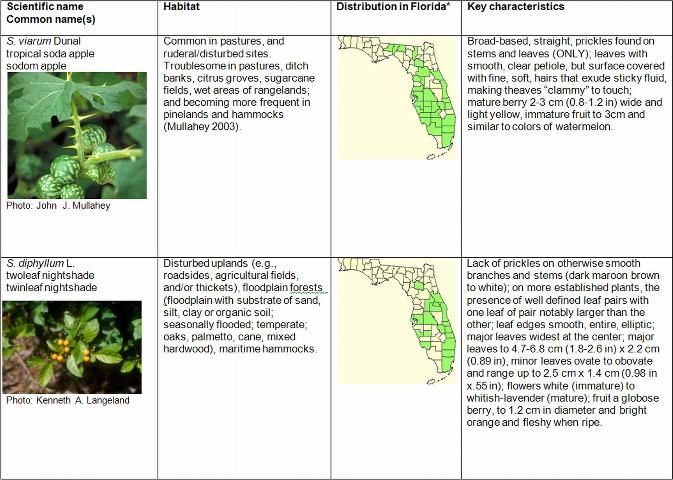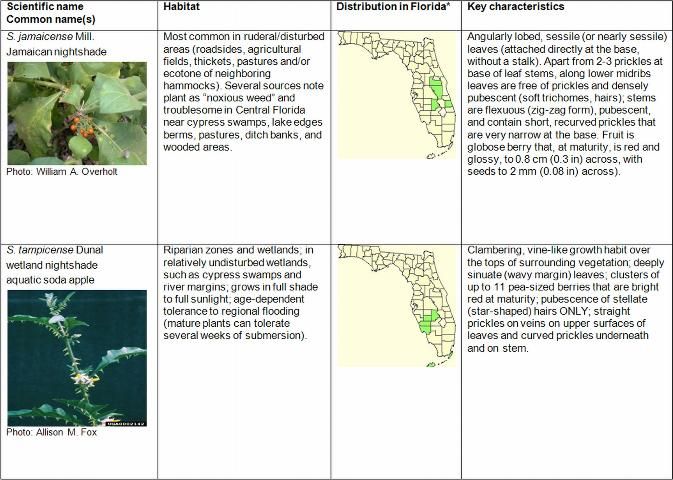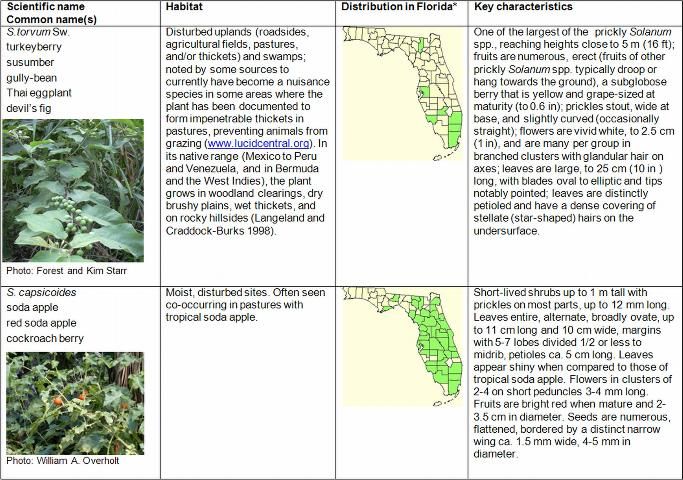Invasive Plants in Natural Areas: Solanum spp. in Florida
Introduction
The Florida Invasive Species Council's (FISC, formerly FLEPPC) 2019 List of Invasive Plant Species includes two Category I and two Category II Solanum species (Solanaceae) (FLEPPC 2007). Category I Solanum species identified by the Council are S. tampicense Dunal (wetland nightshade, aquatic soda apple) and S. viarum Dunal (tropical soda apple). Category II Solanum species identified by the Council are S. diphyllum L. (twoleaf nightshade) and S. torvum Sw. (turkeyberry). Solanum jamaicense Mill. (Jamaican nightshade) was previously included as a Category II species in the 2009 FLEPPC list but was removed in 2011 because of a lack of occurrence data in natural areas.
Category I invasive exotics are defined by FISC as those plants that alter native plant communities by displacing native species, changing community structure or ecological functions, or hybridizing with natives. FISC defines Category II invasive exotics as those that have increased in abundance or frequency, but have not yet altered Florida plant communities to the extent shown by Category I species.
As members of the same genus, the Solanum species identified by FISC as invasive share certain morphological features. These similarities can lead to misidentification. This publication provides a guide to differentiate the invasive Solanum species, along with information about the ecology and management of each species. We have also included information on Jamaican nightshade and another relatively common species, Solanum capsicoides All. (red soda apple), both of which can easily be confused with the invasive Solanum species.
Identification and Florida Distribution
The four Solanum spp. on the FLEPPC's 2019 list and the two other species mentioned above can be identified using morphological characteristics and also by the habitat in which they are found. For example, wetland nightshade (S. tampicense) is found in wetlands, whereas the other five species are typically found in more upland and often disturbed, habitats. Tropical soda apple is found both in open areas with full sun (often in pastures) but also in wooded hammocks. In contrast, Jamaican nightshade is found almost exclusively in or nearby wooded areas.
The following table provides some of the key characteristics that can be used to differentiate the species, as well as information on the habitats in which the species are found and the counties where herbaria specimens have been collected.
Table 1. Identifying characteristics of FISC Category I and Category II Solanum spp. and S. capsicoides.



Native Distribution
The four Solanum spp. on the FISC 2019 list, along with Jamaican nightshade, are native to Mexico, Central America, South America, and/or the Caribbean.
Experts do not agree on the native range of S. capsicoides. Some consider the plant to be a native in Florida (Wunderlin and Hansen 2008) while others believe it is native to the Caribbean (D'Arcy 1974) or to eastern Brazil (Wagner et al. 1999). Regardless of the origin of S. capsicoides, it is not considered to be invasive in Florida. Native and exotic ranges for the six species are indicated in Table 2.
Control Measures
Prior to taking action to control a suspected invasive plant, verify that the plant is an invasive and not a native species. Species verification can be obtained from a local UF/IFAS Extension office (http://sfyl.ifas.ufl.edu/find-your-local-office/).
Chemical
Solanum tampicense. Herbicides that have shown the most promise in controlling this species include glyphosate, 2,4-D, and triclopyr. Aminopyralid should also be effective in seasonally dry wetland areas. However, aminopyralid is not labeled for use when target plants are in water. Seeds buried in the soil have been found to maintain their viability for as long as five years. As such, follow-up site scouting of treated areas and additional treatments of newly germinated plants may be necessary (Langeland and Stocker 2001).
Solanum viarum. Based on research conducted by Ferrell and Mullahey (2006), heavy infestations of tropical soda apple are best controlled by herbicides, such as aminopyralid (Milestone or GrazonNext HL). Field research has shown that aminopyralid provides both pre- and post-emergence control of tropical soda apple for several months following the initial application.
The following application rates for each herbicide are label rates for rangeland/pasture/open space with dense infestations: 1) Milestone, 5–7 oz./acre in at least 20 gallons of water per acre; 2) GrazonNext HL, 1.5–2.1 pints/acre in at least 20 gallons of water per acre. Best results are obtained with the use of a non-ionic surfactant (0.25% v/v) in the spray mix. Spot treatment recommendations include triclopyr (Remedy) or aminopyralid (GrazonNext HL) at 0.5%–1.0% v/v, or Milestone at 0.5 to 0.8 oz. per 2.5 gal. (15–20 ml per 2.5 gal). Consider adding a spray indicator to the herbicide solution to help identify plants that have been treated. It is also recommended that applications are made before early flowering if possible. For more information, see EDIS Publication SSAGR77, Tropical Soda Apple: Biology, Ecology and Management of a Noxious Weed in Florida, https://edis.ifas.ufl.edu/UW097.
For triclopyr, an integrated approach with mowing is required to obtain best control. Old infestations and/or newly germinating patches must be mowed regularly through April) to control budding and flowering. Following this, a broadcast treatment of 1 quart triclopyr in 40 gallons of water/acre is recommended 50–60 days after the April mowing (late May–June). Follow up with spot treatments (1–1.5 gallons of Remedy Ultra in 100 gallons of total spray mixture) of remaining plants or newly germinated plants.
Solanum jamaicense/Solanum diphyllum. No research has been conducted on chemical control methods for either of these plants. Control methods developed for tropical soda apple (Solanum viarum) may be tried (see above) on these plants. Aminopyralid is very likely to be effective due to its high level of efficacy on other Solanum species.
Solanum torvum. Control of turkeyberry has been achieved chemically on the Hawaiian Islands, where the plant has been found to be susceptible to glyphosate (Swarbrick 1997).
Biological
Solanum viarum. In early 2003, the South American tropical soda apple leaf beetle, Gratiana boliviana (Coleoptera: Chrysomelidae) was released in Florida for biological control of tropical soda apple. Since then, more than 250,000 beetles have been released in over 40 counties in Florida. In addition, this beetle has been released in Georgia, Alabama, South Carolina, and Texas. The beetles are well established in Florida and cause considerable damage to tropical soda apple populations. In many cases, the beetles provide sufficient control and no additional control tactics are not required. However, damage due to tropical soda apple by the beetle was much more extensive in areas below 29° N latitude (Diaz et al. 2013). For more detailed information on the TSA beetle, see EDIS publication ENY-865 Classical Biological Control of Tropical Soda Apple with Gratiana boliviana (https://edis.ifas.ufl.edu/publication/in974).
References
D'Arcy, W.G. 1974. "Solanum and its close relatives in Florida." Annals Missouri Botanical Garden 61: 819–867.
Diaz, Rodrigo, William A. Overholt, Ken Hibbard, and Julio Medal. 2013. Tropical soda apple leaf beetle, Gratiana boliviana Spaeth (Insecta: Coleoptera: Chrysomelidae: Cassidinae). EENY-543. Gainesville: University of Florida Institute of Food and Agricultural Sciences. https://edis.ifas.ufl.edu/publication/in974
Sellers, Brent, Jay Ferrell, J. Jeff Mullahey and Pat Hogue. 2006 and 2009. Tropical Soda Apple: Biology, Ecology and Management of a Noxious Weed in Florida. SS-AGR-77. Gainesville: University of Florida Institute of Food and Agricultural Sciences. https://edis.ifas.ufl.edu/UW097
FLEPPC. 2017. "Florida Pest Plant Council Invasive Species List, 2017." Available at http://bugwoodcloud.org/CDN/fleppc/plantlists/2017/2017FLEPPCLIST-TRIFOLD-FINALAPPROVEDBYKEN-SUBMITTEDTOALTA.pdf
Hickman, J. C. (Eds.). 1993. The Jepson Manual. Berkeley, CA: University of California Press.
Langeland, K. A., and K. Craddock-Burks. (Eds.). 1998. Identification and Biology of Non-Native Plants in Florida's Natural Areas. Gainesville, FL: University of Florida.
Langeland, K. A. and R. K. Stocker. 2001. Control of Non-native Plants in Natural Areas of Florida. SP242. Gainesville: University of Florida Institute of Food and Agricultural Sciences. https://edis.ifas.ufl.edu/WG209
Mullahey, J. J. 2003. "Tropical Soda Apple: A Short Summary on the Biology and Description of S. viarum." http://tsa.ifas.ufl.edu
Swarbrick, J.T. 1997. Weeds of the Pacific Islands. Noumea, New Caledonia: South Pacific Commission.
USDA/ARS. 2006. "Germplasm Resources Information Network (GRIN)." http://www.ars-grin.gov/cgi-bin/npgs/html/taxon.pl?101505
Wagner, W.L., D.R. Herbst, and S.H. Sohmer. 1999. Manual of the Flowering Plants of Hawai'i. 2 vols. Bishop Museum Special Publication 83. Honolulu, HI: University of Hawai'i and Bishop Museum Press.
Wunderlin, R. P. and B. F. Hanson. 2008. "Atlas of Florida vascular plants." Institute for Systematic Botany, University of South Florida. http://www.plantatlas.usf.edu/


